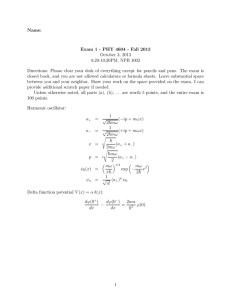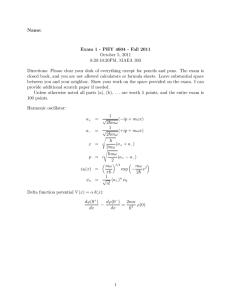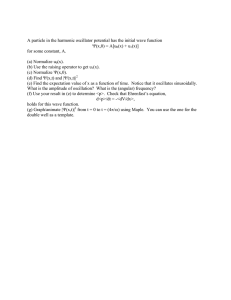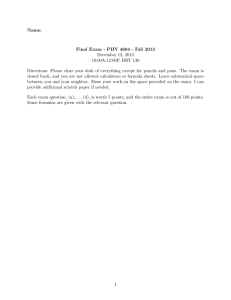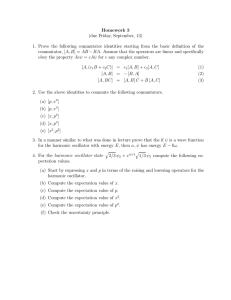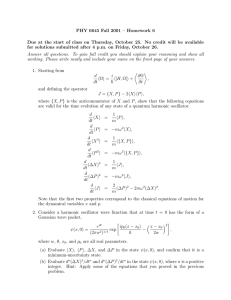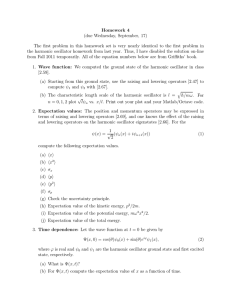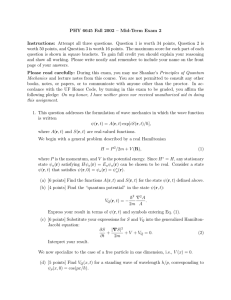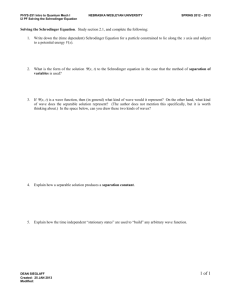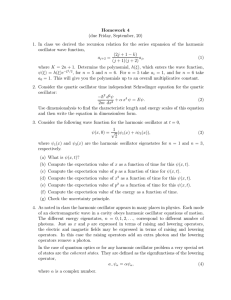Name: Exam 1 - PHY 4604 - Fall 2012 October 3, 2012
advertisement
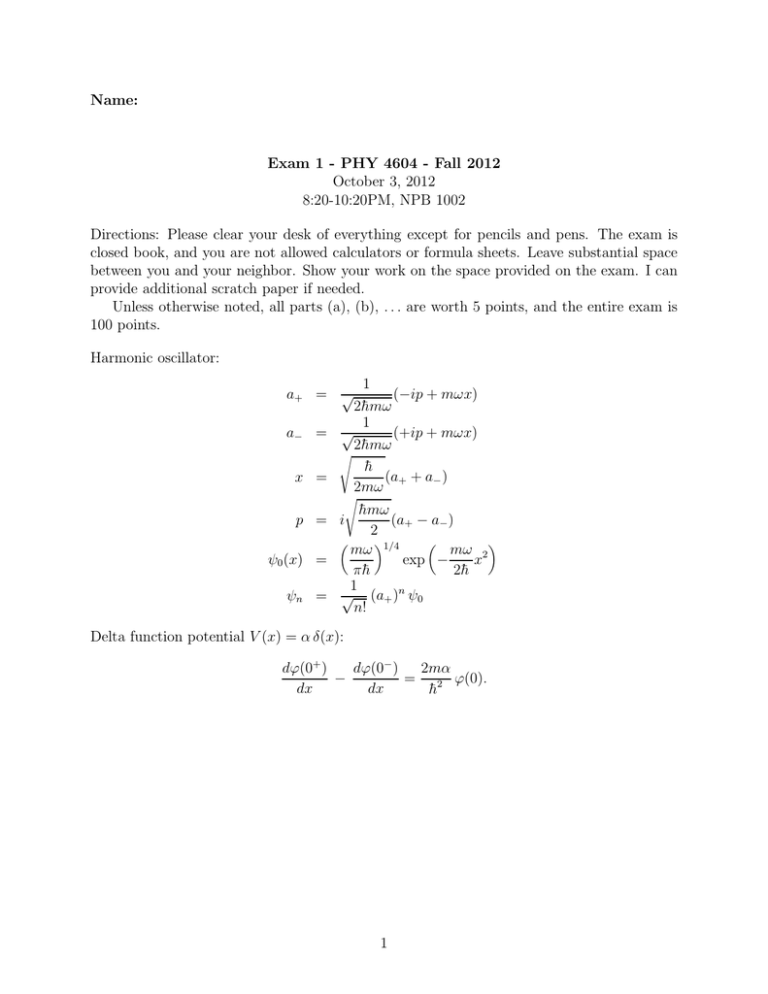
Name: Exam 1 - PHY 4604 - Fall 2012 October 3, 2012 8:20-10:20PM, NPB 1002 Directions: Please clear your desk of everything except for pencils and pens. The exam is closed book, and you are not allowed calculators or formula sheets. Leave substantial space between you and your neighbor. Show your work on the space provided on the exam. I can provide additional scratch paper if needed. Unless otherwise noted, all parts (a), (b), . . . are worth 5 points, and the entire exam is 100 points. Harmonic oscillator: 1 (−ip + mωx) 2h̄mω 1 a− = √ (+ip + mωx) 2h̄mω s h̄ (a+ + a− ) x = 2mω a+ = √ s h̄mω (a+ − a− ) 2 mω 1/4 mω 2 ψ0 (x) = x exp − πh̄ 2h̄ 1 ψn = √ (a+ )n ψ0 n! p = i Delta function potential V (x) = α δ(x): dϕ(0+ ) dϕ(0− ) 2mα − = 2 ϕ(0). dx dx h̄ 1 1. Short answer section (a) Write down the time independent Schrodinger equation in one dimension. (b) For the harmonic oscillator, what is (a− a+ − a+ a− )? (c) Give an expression for the probability current. (d) Write down a general expression for ψ(x, t) for the one dimensional Schrodinger equation with V (x) = 0. (e) State the uncertainty principle. 2 2. General properties At t = 0 the wave function of a particle in an infinite square well between x = 0 and x = a is ψ(x, 0) = 0 for 0 < x < a/4 ψ(x, 0) = C for a/4 < x < 3a/4 ψ(x, 0) = 0 for 3a/4 < x < a. (1) (2) (3) (a) What is the constant C so that the wave function is normalized? (b) Compute the expectation values hxi, hx2 i, as well as σx for ψ(x, 0). You may use the symmetry in the problem. 3 (c) Express ψ(x, 0) as a linear combination of the eigenstates of the infinite square well, ψn (x), ψ(x, 0) = ∞ X cn ψn (x), n=1 by calculating the coefficients cn . Are any of the cn zero? If so, which ones? (d) Use the result of part (c) to write down an expression for ψ(x, t). (e) What is the smallest time, τ , for which |ψ(x, τ )|2 = |ψ(x, 0)|2 ? 4 (4) 3. Harmonic oscillator At t = 0 the wave function of a particle in a harmonic oscillator potential is given by 1 i ψ(x, 0) = √ ψ1 (x) − √ ψ3 (x). 2 2 (a) What is ψ(x, t)? (b) What is the expectation value of x2 for ψ(x, t)? 5 . (c) What is the expectation value of p2 for ψ(x, t)? 6 (d) What is the expectation value of the energy for ψ(x, t)? (e) Determine σx σp for ψ(x, t) and show that the uncertainty principle is satisfied. 7 4. Piecewise constant and delta function potentials For this problem us the one dimensional time independent Schrodinger equation with potential V (x) = 0 for x < −a V (x) = Vo > 0 for − a < x < 0 V (x) = ∞ for x > 0. (5) (6) (7) The energy of the particle is in the range 0 < E < Vo . (a) For 0 < E < Vo , what is the general form of the solution? Make sure to define all the variables that you introduce. (b) What is the boundary condition for an infinite square well? This is the same boundary condition as we have in this problem at x = 0. Apply this boundary condition to eliminate one of the coefficients in part (a). (c) What is the boundary condition at x = −a applied to the wave function in part (a)? 8 (d) (10 points) Solve for the coefficients of part (a) assuming that the coefficient of the incoming wave from the left (eikx ) is one. Use these coefficients to evaluate the reflection probability. 9
